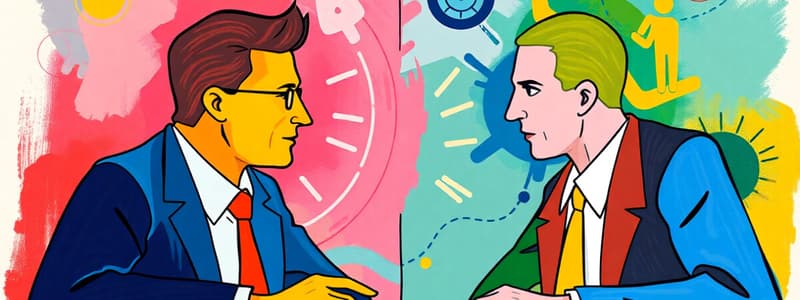Podcast
Questions and Answers
What is the primary focus of efficiency in management?
What is the primary focus of efficiency in management?
- Attaining organizational goals
- Coordinating employee efforts
- Making organization-wide decisions
- Getting the most output for the least inputs (correct)
Which type of manager is responsible for overseeing the work of non-managerial employees?
Which type of manager is responsible for overseeing the work of non-managerial employees?
- Executive Managers
- First-line Managers (correct)
- Middle Managers
- Top Managers
Which managerial function involves defining goals and establishing strategies to achieve them?
Which managerial function involves defining goals and establishing strategies to achieve them?
- Planning (correct)
- Leading
- Controlling
- Organizing
What do effectiveness and efficiency have in common in management?
What do effectiveness and efficiency have in common in management?
Which of the following roles is NOT identified by Mintzberg as a role played by managers?
Which of the following roles is NOT identified by Mintzberg as a role played by managers?
In what way do middle managers contribute to an organization?
In what way do middle managers contribute to an organization?
What is the primary goal of controlling as a managerial function?
What is the primary goal of controlling as a managerial function?
How does effectiveness differ from efficiency in a managerial context?
How does effectiveness differ from efficiency in a managerial context?
What is a key characteristic of modern HRM in the digital age?
What is a key characteristic of modern HRM in the digital age?
Which practice emphasizes the assessment of employee performance linked to business outcomes?
Which practice emphasizes the assessment of employee performance linked to business outcomes?
How has technology impacted HR practices?
How has technology impacted HR practices?
What does the emphasis on learning and development in modern HRM focus on?
What does the emphasis on learning and development in modern HRM focus on?
Which approach is now integrated into HRM to enhance workplace culture?
Which approach is now integrated into HRM to enhance workplace culture?
What is a defining feature of data-driven HR?
What is a defining feature of data-driven HR?
What is the main focus of talent management in HR practices?
What is the main focus of talent management in HR practices?
What does strategic alignment in HR practices involve?
What does strategic alignment in HR practices involve?
Which type of skill involves the ability to work well with others?
Which type of skill involves the ability to work well with others?
What characterizes an organization?
What characterizes an organization?
During the Early Industrial Revolution, what was a significant change in management approach?
During the Early Industrial Revolution, what was a significant change in management approach?
Which of the following skills involves proficiency in a specific field?
Which of the following skills involves proficiency in a specific field?
What was a key characteristic of the Pre-Industrial Revolution workforce?
What was a key characteristic of the Pre-Industrial Revolution workforce?
What major concern arose during the Early Industrial Revolution regarding workers?
What major concern arose during the Early Industrial Revolution regarding workers?
What does conceptual skill enable a manager to do?
What does conceptual skill enable a manager to do?
What was one of the primary focuses of labor management before the 18th century?
What was one of the primary focuses of labor management before the 18th century?
What was the primary focus of personnel management during the late 19th century to mid 20th century?
What was the primary focus of personnel management during the late 19th century to mid 20th century?
Which of the following movements influenced human resource management in the mid 20th century?
Which of the following movements influenced human resource management in the mid 20th century?
What key characteristic marked the transition from personnel management to human resource management?
What key characteristic marked the transition from personnel management to human resource management?
During the personnel management era, which of the following was a significant area of focus?
During the personnel management era, which of the following was a significant area of focus?
What was a defining shift in the role of human resources during the strategic human resource management era of the 1990s?
What was a defining shift in the role of human resources during the strategic human resource management era of the 1990s?
Which motivational theory influenced HR practices during the personnel management era?
Which motivational theory influenced HR practices during the personnel management era?
Which aspect of HR began to gain attention during the human resource management era?
Which aspect of HR began to gain attention during the human resource management era?
What did the Hawthorne studies primarily highlight in relation to human resource management?
What did the Hawthorne studies primarily highlight in relation to human resource management?
Flashcards
What is a Manager?
What is a Manager?
A person who coordinates and supervises the work of others to achieve organizational goals.
Who are First-line Managers?
Who are First-line Managers?
Individuals who manage the work of non-managerial employees.
Who are Middle Managers?
Who are Middle Managers?
Individuals who manage the work of first-line managers.
Who are Top Managers?
Who are Top Managers?
Signup and view all the flashcards
What is Efficiency?
What is Efficiency?
Signup and view all the flashcards
What is Effectiveness?
What is Effectiveness?
Signup and view all the flashcards
What are Manager Roles?
What are Manager Roles?
Signup and view all the flashcards
Explain Mintzberg's Managerial Roles.
Explain Mintzberg's Managerial Roles.
Signup and view all the flashcards
Human Skills
Human Skills
Signup and view all the flashcards
Technical Skills
Technical Skills
Signup and view all the flashcards
Conceptual Skills
Conceptual Skills
Signup and view all the flashcards
What is an Organization?
What is an Organization?
Signup and view all the flashcards
Distinct Purpose
Distinct Purpose
Signup and view all the flashcards
Composed of People
Composed of People
Signup and view all the flashcards
Deliberate Structure
Deliberate Structure
Signup and view all the flashcards
Early Industrial Revolution
Early Industrial Revolution
Signup and view all the flashcards
Personnel Management Era
Personnel Management Era
Signup and view all the flashcards
Human Resource Management Era
Human Resource Management Era
Signup and view all the flashcards
Human Relations Movement
Human Relations Movement
Signup and view all the flashcards
Strategic Human Resource Management (HRM)
Strategic Human Resource Management (HRM)
Signup and view all the flashcards
Frederick Taylor's Scientific Management
Frederick Taylor's Scientific Management
Signup and view all the flashcards
Hawthorne Studies
Hawthorne Studies
Signup and view all the flashcards
Maslow’s Hierarchy of Needs
Maslow’s Hierarchy of Needs
Signup and view all the flashcards
Collective Bargaining
Collective Bargaining
Signup and view all the flashcards
Strategic Alignment in HR
Strategic Alignment in HR
Signup and view all the flashcards
Data-Driven HR
Data-Driven HR
Signup and view all the flashcards
Performance Management Systems
Performance Management Systems
Signup and view all the flashcards
Talent Management
Talent Management
Signup and view all the flashcards
Workplace Diversity and Inclusion
Workplace Diversity and Inclusion
Signup and view all the flashcards
HR Agility and Innovation
HR Agility and Innovation
Signup and view all the flashcards
Technological Advancements in HR
Technological Advancements in HR
Signup and view all the flashcards
Employee Experience
Employee Experience
Signup and view all the flashcards
Study Notes
Introduction to Business - Chapter 7: Manager and Human Resources
- Learning Outcomes: Define manager and explain why efficiency and effectiveness are important to management. Explain the characteristics of an organization.
Who Are Managers?
- Manager Definition: Someone who coordinates and supervises the work of other people to achieve organizational goals.
Classifying Managers
-
First-line Managers: Manage the work of non-managerial employees.
-
Middle Managers: Manage the work of first-line managers.
-
Top Managers: Responsible for organization-wide decisions, establishing plans and goals affecting the entire organization.
-
Managerial Levels: Exhibit 1-2 illustrates a hierarchical structure: Top Managers, Middle Managers, First-Line Managers, and Nonmanagerial Employees.
Managerial Concerns
- Efficiency: Doing things "right" - getting the most output for the least input.
- Effectiveness: Doing the "right things" - achieving organizational goals.
- Relationship (Exhibit 1-3): Management strives for both high efficiency (low waste) and high effectiveness (achieving goals).
What Managers Do
- Defining Managers (Three Approaches): Functions performed, roles played, and skills needed.
Functions Managers Perform
- Planning: Defining goals, establishing strategies to achieve goals, developing integrated plans.
- Organizing: Arranging and structuring work to achieve organizational goals.
- Leading: Working with people to achieve goals.
- Controlling: Monitoring, comparing, and correcting work.
Roles Managers Play
- Roles are Specific Actions: Behaviors expected of managers, grouped around interpersonal relationships, information transfer, and decision-making (Mintzberg's 10 roles).
Skills Managers Need
-
Technical skills: Knowledge and proficiency in a specific field.
-
Human skills: Ability to work well with others.
-
Conceptual skills: Ability to think and conceptualize abstract and complex situations concerning the organization.
-
Skill Levels by Management Level (Exhibit 1-6): Top managers require more conceptual skills, middle managers require a balance of skills, and lower-level managers need more technical skills.
What is an Organization?
- Definition: A deliberate arrangement of people to accomplish some specific purpose not achievable independently.
- Common Characteristics:
- Have a distinct purpose (goal).
- Composed of people.
- Have a deliberate structure.
- Exhibit 1-9 illustrates the interdependence of distinct purpose, deliberate structure, and people.
Learning Outcome 6
- Understanding human resource development
Pre-Industrial Revolution (Before 18th Century)
- Focus: Informal management, roles & work conditions determined by guilds, apprenticeships, or family structures. Work task oriented and localized; minimal attention to employee welfare.
Early Industrial Revolution (Late 18th Century - Early 19th Century)
- Focus: Rise of factories, business expansion, need for a more structured approach to managing large workforces.
- Characteristics: increase in factory-based work, emergence of "personnel management", concern over working conditions, child labor, and worker exploitation.
Personnel Management Era (Late 19th Century - Mid 20th Century)
- Focus: Personnel management as a separate administrative function; hiring, payroll, record-keeping, employee welfare; reactive focus, emphasizing compliance and discipline.
- Characteristics: Welfare work, labor relations, bureaucratic systems, early motivational theories (Taylor, Hawthorne Studies).
Human Resource Management Era (Mid 20th Century - 1980s)
- Focus: HRM as a key resource in organizational success; more strategic focus on improving employee performance.
- Characteristics: Human relations movement, strategic management, employee development, legal framework.
Strategic Human Resource Management (1990s - Early 2000s)
- Focus: Aligning HR practices with organizational goals; strategic role of HRM in business decision-making.
- Characteristics: Strategic alignment, performance management (e.g., 360-degree feedback), talent management, workplace diversity, and technology advancements.
Modern HRM and the Digital Age (2000s - Present)
- Focus: HRM as a key partner in organizational success. Data-driven decisions, employee experience, well-being, and career growth.
- Characteristics: Data-driven HR, employee experience focus, agility & innovation, and responsive workforce management.
Diversity, Equity, and Inclusion (DEI)
- Focus: HR plays a major role in fostering diverse and inclusive workplaces promoting equity in employment.
Learning and Development
- Focus: Continuous learning, personalized learning programs, and upskilling opportunities.
Globalization
- Focus: Managing a global workforce with diverse cultures and economic factors.
Future of HR (Emerging Trends)
- Focus: Advanced technology, personalized employee experiences, and remote/hybrid work models.
- Characteristics: Artificial intelligence and automation, responsive workforce management, work-life balance and well-being, ethical and transparent leadership.
Studying That Suits You
Use AI to generate personalized quizzes and flashcards to suit your learning preferences.




